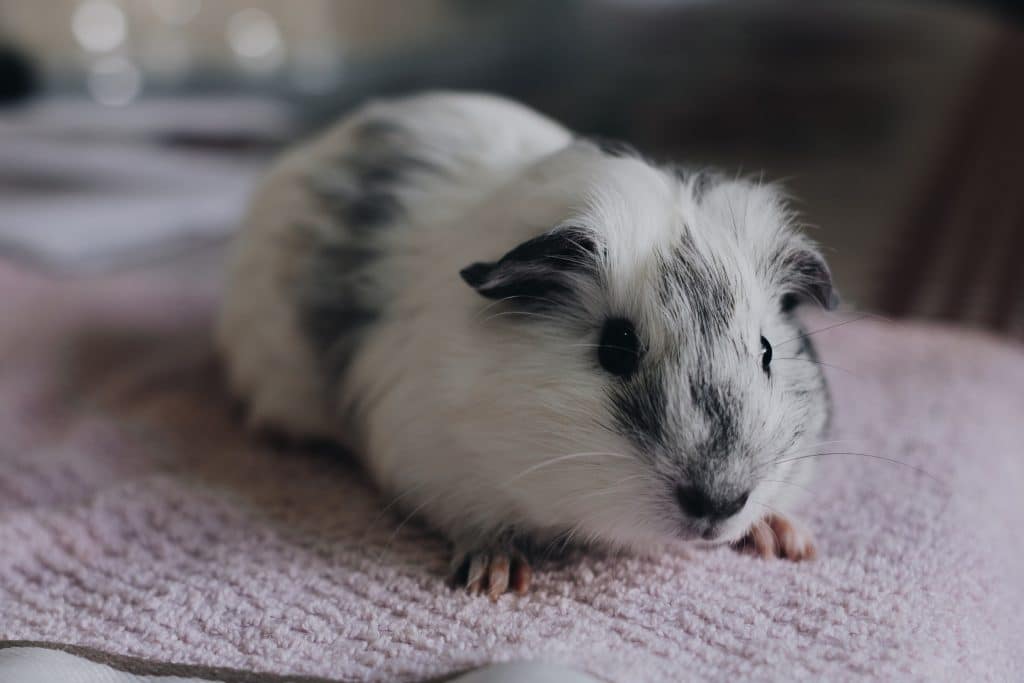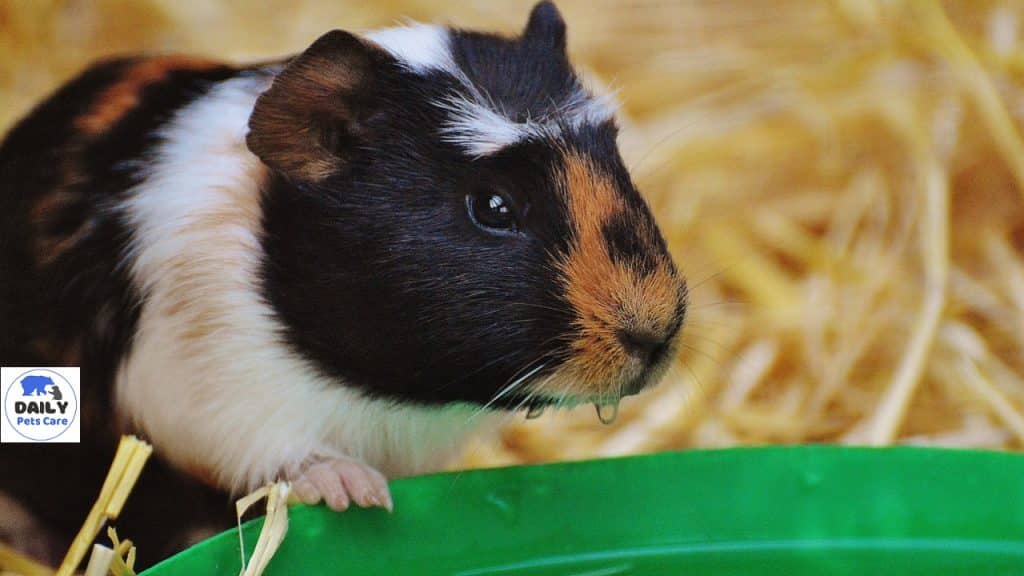Does your guinea pig have almond-shaped eyes? Are their feet tiny, with their body appearing plump? Maybe their ears are small as well.
Upon searching for these signs, you find they are indicators of Down syndrome. So, can guinea pigs have Down syndrome?
Guinea pigs cannot have Down syndrome, but they can suffer from other syndromes like Cushing’s, Vestibular, and Horner’s that may exhibit similar symptoms. Common traits of Down syndrome are a disfigured face with massive weight while some parts, like the neck and feet, are smaller than usual.
What is Down Syndrome?
Down syndrome is a genetic condition that occurs when there is an additional copy of chromosome 21.
This means there are extra genes on this particular chromosome, and it can cause problems in many different areas of life, including:
- Physical development
- Learning disabilities
- Heart defects
- Vision impairment
- Hearing loss
- Immune system disorders
- Gastrointestinal issues
- Breathing difficulties
- Seizures
- Sleep disturbances
- Behavioral challenges
There are three Down syndrome types. However, it’s challenging to differentiate them as patients exhibit similar physical traits.
Firstly, there is trisomy 21, in which an individual has three copies of chromosome number 21 instead of the usual two. Trisomy 21 is the most common.
Next is translocation Down syndrome, in which a portion or entire extra chromosome 21 gets attached to another chromosome.
Finally, there is a mosaic Down syndrome in which some but not all cells contain an extra chromosome 21.
What Are Common Traits of Down Syndrome?
When looking at a victim with Down syndrome, the first thing you notice is how much larger than usual they appear. Those with this syndrome tend to be obese.

Moreover, they usually weigh heavier than most of their agemates. As a result, they tend to look like miniature adults because of their head and shoulder shapes.
Their faces appear rounder and fuller due to excess fat deposits around their cheeks and chin area.
The most common symptoms include:
- A small, round head
- Small eyes set close together
- Tiny ears
- Short neck
- Flat face
- A large tongue that may poke outside the mouth
- Tiny feet
- White-spotted iris
- Loose joints
- Low muscle tone
Can Guinea Pigs Get Down Syndrome?
Like other animals besides apes, guinea pigs cannot get Down syndrome. Piggies have a chromosomal arrangement different from ours.
Nonetheless, guinea pigs have ordered chromosomes like other animals, leading to the interdependence between them. Because of this, guinea pigs can experience issues resembling Down syndrome.
These problems can result in physiological and cognitive challenges, plus anatomical alterations that may change the pig’s physical traits.
You might also want to read: What Do Guinea Pigs Like to Do with Humans?
Certain animals may exhibit trisomy in particular chromosomes, for example, trisomy 16 in mice. However, down syndrome is an ailment specifically resulting from trisomy 21 or 22 for apes. Therefore, it doesn’t affect most animals, and guinea pigs are no different.
If your piggie develops symptoms that resemble those of Down syndrome, it could be due to another disease.
What Signs in Guinea Pigs Resemble Down Syndrome?
Some of the symptoms that resemble Down syndrome in guinea pigs include:
- Large body size (obesity)
- A round head
- Round ears
- Flat face
- Crossed eyes
- Abnormal gait
- Short snoot
Syndromes That May Affect Guinea Pigs
Although your guinea pig may not suffer from Down syndrome, other syndromes may also interfere with their daily functions and happiness, as discussed below.
Hyperadrenocorticism or Cushing’s syndrome
Cushing’s disease results from high levels of cortisol getting produced within the adrenal glands. Cortisol is a hormone that helps regulate blood sugar levels, metabolism, mood, appetite, energy level, bone growth, muscle strength, and sexual function.

In addition, cortisol plays a role in regulating stress responses and maintaining homeostasis.
Cushing’s disease causes excessive amounts of cortisol to build up inside the adrenals. Because of this, there may be several symptoms, including:
- Weight loss
- Increased thirst and urination
- Behavioral changes
- Depression, anxiety, fatigue
- Hair loss
- Thinning of bones
- Decreased activity
Mild cases can cause only subtle effects, including lethargy, weakness, poor coat condition, diarrhea, vomiting, abdominal pain, and fever. Severe cases can lead to death if left untreated.
While it’s a bit challenging to diagnose this syndrome, your vet can help you identify whether your guinea pig has it.
Testing typically involves:
- Looking at the outward signs.
- Checking cortisol levels.
- Adrenocorticotropic hormone stimulation testing.
- Abdominal ultrasound.
If confirmed, treatment involves administering trilostane, L-deprenyl, or Cushex. While L-deprenyl operates by reducing the adrenal gland sizes, Cushex works by soothing these glands to avoid hormonal overproduction.
Vestibular Syndrome
This syndrome occurs when one side of the vestibule enlarges, causing balance problems. The vestibular syndrome may happen when a guinea pig gets injured on one side of their ear canals, leading to swelling and inflammation.
Often, the affected side becomes painful and swollen, while the opposite side remains unaffected.
Symptoms include:
- Corneal ulceration
- Head tilt
- Unsteadiness
- Difficulty walking
- Low eye responsiveness
- Weight loss
- Hearing loss
Diagnosis requires a physical examination followed by an otoscopy.
Plus, tympanometry. Treatment includes antibiotics and antihistamines.
Horner’s Syndrome
Horner’s syndrome is a disorder where one side of the body does not receive enough stimulation from nerves originating in the opposite hemisphere of the brain.
As a result, the eye muscles do not contract properly, causing a lack of sweating on the affected side and sunken eyeballs.
However, the most common symptom of Horner’s syndrome is a droopy eyelid on one side of the face. Other signs that indicate the presence of this disease include;
- Dry skin around the nose
- Decreased tear secretion
- Reduced pupil size
- Difficulty moving eyeballs
- Inability to close both eyes at once
- Elevated third eyelid
Horner’s syndrome usually develops after birth but sometimes appears later in life. Most often, it happens due to injury to the spinal cord. Even so, it can occur spontaneously without apparent causes.
Types of Horner’s Syndrome
Three categories of damage may lead to Horner’s syndrome, first, second, and third-order.
The first order results from brain and spinal cord damage, while the second is due to damage between your piggie’s skull base and chest cavity. Lastly, the third order occurs from damage between the eyes and skull base.
A vet uses eye drops to stimulate the nervous system to determine which section of the body is causing the problem.
Identifying whether the syndrome is first, second, or third-order helps shed light on potential causes of the defect. Moreover, it aids the vet in identifying any other issues around the affected area.
For instance, exposure to Cushing’s syndrome may also increase the chances of developing Horner’s first-order syndrome. Often, the first order is due to spinal and head trauma.
A guinea pig with the syndrome’s second order may suffer from neck trauma or thoracic ailments like chest cavity tumors.
Finally, the third order is typically due to ear infections.
Treatment
Besides medical care, veterinarians may use surgical procedures like Conjunctival-Mullerectomy to correct the problem.
Often, the syndrome does not require much attention as it doesn’t affect the sight capabilities of your pet. If you wish, your vet may use eye drops applied during diagnosis to treat it temporarily.
Nonetheless, a few cases of the disease may impair the proper functioning of your guinea pig’s eyesight. In such instances, your vet may recommend sympathomimetic drops. These are eye drops that function similarly to the sympathetic system.
Also, the vet may administer an anti-inflammatory drug to suppress some symptoms of the disease.
Satin Syndrome in Guinea Pigs
Do you have a guinea pig with a shiny coat that you love to look at? While this may mean nothing besides beauty, a shiny coat is sometimes an indicator of Satin syndrome. The satin syndrome arises from a mutation that affects guinea pig hair.
In most cases, this syndrome causes osteodystrophy, a bone ailment. Unfortunately, osteodystrophy is intensely painful and incurable.
Signs may appear within a year.
Piggies ailing from this bone disease have a short lifespan and may exhibit any of these symptoms:
- Dental problems
- Improper posture
- Stiff joints
- Birth complications
- Lower weight than peers
- Retarded growth
Bones end up being brittle and tender. The only remedy is pain relief, and care may also involve coronal teeth reduction while providing a balanced diet.
Caring for piggies with osteodystrophy is a bit pricey as it encompasses getting pain relief medication and X-rays besides the usual shelter and food provisions.
In severe cases, you may have to opt for euthanization, especially if you can’t stand to watch your piggie in agony.
So, Can Guinea Pigs Have Down Syndrome?
If you notice your guinea pig has several deformities, you don’t need to worry about a Down syndrome diagnosis. Maybe, the problem stems from inbreeding or another syndrome.
That said, talk to your vet, and they can help you and your guinea pig find a solution and hopefully be more at ease.


